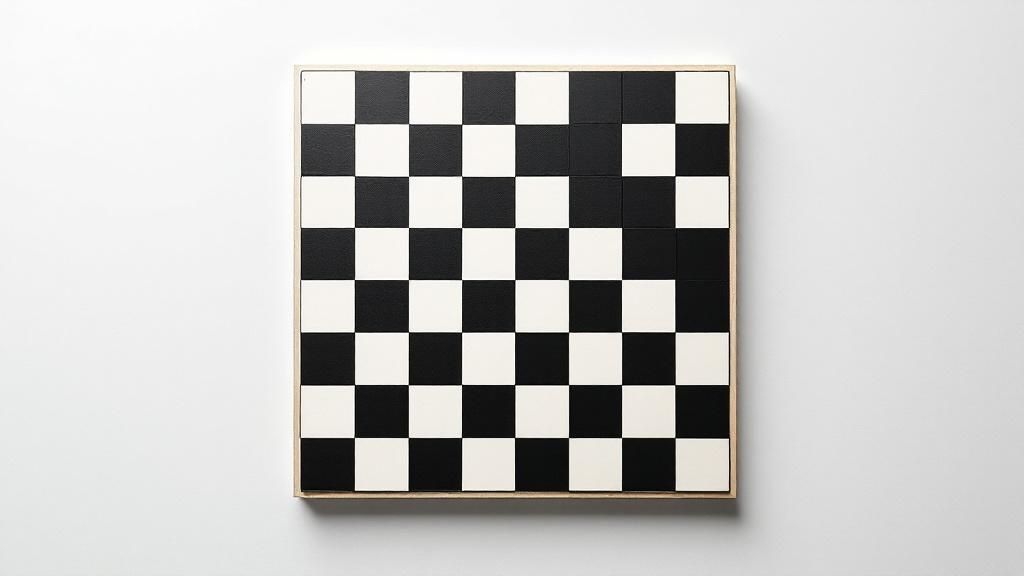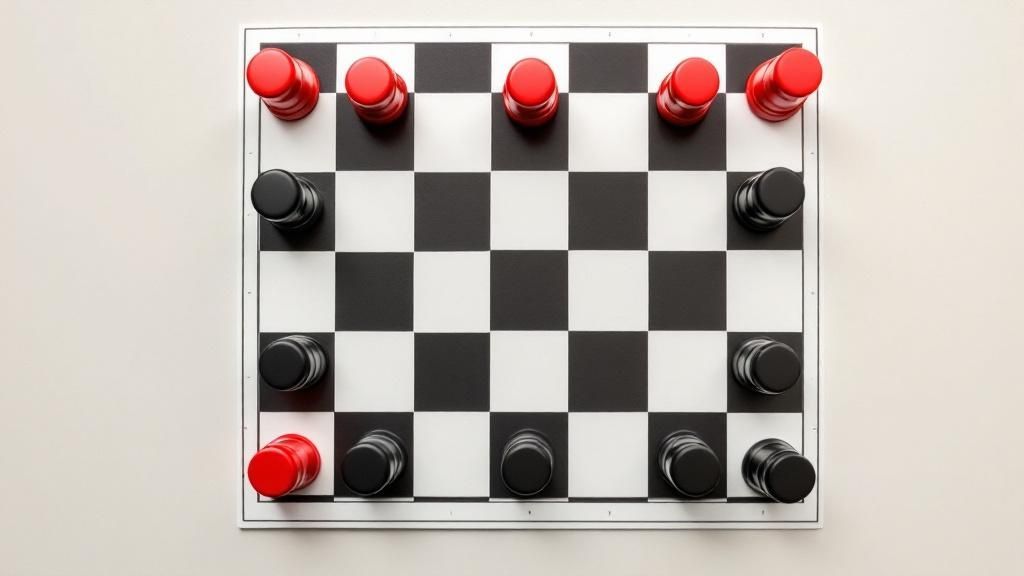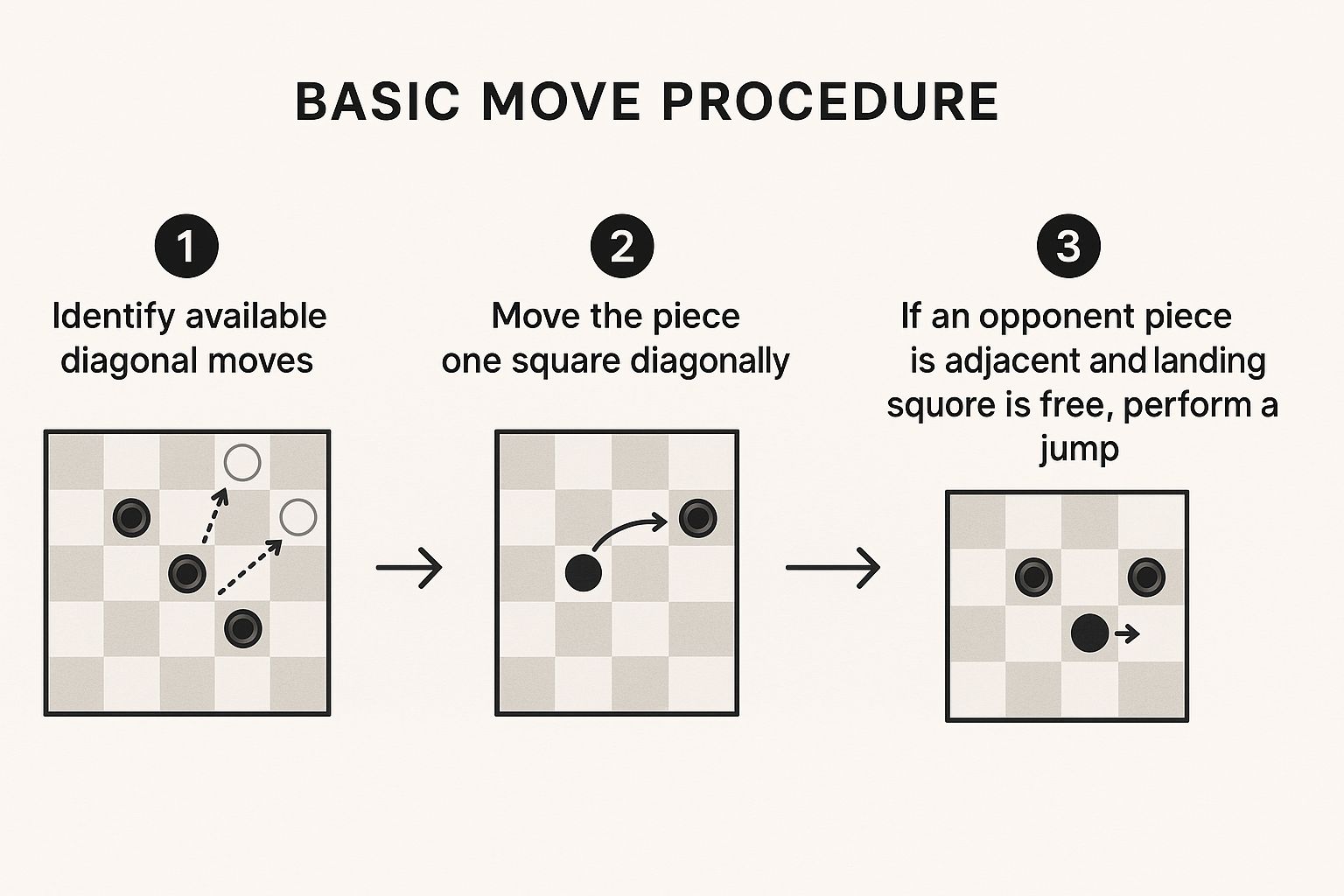Welcome to the world of checkers, a game of brilliant, straightforward strategy that has captivated players for centuries. The objective is clear: capture all of your opponent's pieces or cleverly trap them so they have no moves left. This guide will walk you through the essential rules and, more importantly, help you start thinking like a seasoned player.
Your First Steps Into the World of Checkers

Checkers, or draughts as it's known in many parts of the world, is a classic two-player game where foresight and positioning are everything. It’s played on an 8x8 board with alternating light and dark squares—the very same one used for chess. This shared board is a big reason for the game's lasting appeal; many households already have one.
Because of this, if you're in the market for a new set, looking into the 7 best chess sets for beginners can be a fantastic way to get a high-quality board that serves both games perfectly.
The Core Objective
At its heart, your mission in checkers is to systematically remove your opponent's pieces from the board. You do this by making captures, or "jumps," which we’ll cover in just a moment. However, there's a more subtle path to victory: cornering your opponent until they have no legal moves left.
The game is a contest of attrition and positioning. You win either by removing the opponent's army or by rendering it completely immobile. Both paths require a different strategic approach.
This dual-win condition adds a surprising layer of depth. From experience, I can tell you that sometimes sacrificing one of your own pieces is the best move you can make. It can open up the board and lead to a superior position that ultimately traps the enemy. It's more than a race to capture; it's a battle for control.
Why Checkers Endures
Board games are more than just a pastime; they're a cornerstone of social connection. The global board game market was valued at an impressive $11.88 billion in 2022, proving their staying power in our digital age.
In fact, research shows that 50.6% of U.S. adults feel that increased social opportunities are a key benefit of playing board games, and checkers is a perfect example. It's a fantastic way to engage with someone face-to-face.
Before we dive into setting up the board and moving pieces, let’s go over the essentials.
Checkers Essentials at a Glance
Here’s a quick summary of what you need to know before you make your first move. This table breaks down the fundamental components of the game.
| Component | Objective |
|---|---|
| Players | 2 |
| Board | 8x8 grid of 64 squares |
| Pieces | 12 per player (often called 'men') |
| Goal | Capture all 12 opposing pieces or block them from moving. |
With these basics in mind, you're ready to learn how the game is truly played on the board. Let's get started.
Setting Up the Board for a Fair Game

Every great game of checkers starts with a proper setup. Before you can even think about strategy, you need to lay the groundwork for a fair and legitimate match. Getting this right is fundamental to the rules of checkers.
First things first, let's orient the board. This is a small detail that’s surprisingly easy to get wrong, but it’s crucial for standardized play. Sit across from your opponent and turn the board so that each player has a light-colored square in their bottom-right corner. Think of it as your anchor square.
Arranging Your Pieces
With the board in position, it's time to arrange your army. You and your opponent each have 12 pieces. A key difference from chess is that in checkers, the entire game unfolds on the dark squares only.
If you're familiar with other board games, you might find the setup contrasts interesting. For instance, understanding how to set up a chess board correctly highlights just how different the starting formations can be.
Here's how to place your 12 checkers:
- Take your 12 pieces and place them on the dark squares of the three rows closest to you.
- This means you'll fill all available dark squares in your first, second, and third rows.
- The result is a solid block of your pieces, ready for action.
This configuration leaves the two central rows of the board completely empty, creating a kind of "no-man's-land" between you and your opponent.
Tradition dictates that the player with the darker pieces (typically black or red) makes the first move. This simple rule gets the game started smoothly without any debate over who begins.
Once all 24 pieces are in place and the board is correctly positioned, you're ready to go. This meticulous setup ensures both players begin on an absolutely even footing, making the game a pure test of skill and foresight. Now, it's time for that opening move.
Making Moves and Capturing Pieces
Alright, now we get to the heart of the game: moving your checkers and taking your opponent's. This is where strategy really starts to unfold. Every move you make can either open up an opportunity or put you in a tough spot. To get good at checkers, you have to get a feel for the basic moves and, most importantly, the absolute must-do rule of capturing.
A regular checker, sometimes called a 'man,' moves in a very specific way. It travels one space at a time, always diagonally forward, and only onto an unoccupied dark square. Think of your pieces as an army constantly pushing toward your opponent’s home row. It's a key point to remember: all the action in checkers happens on those 32 dark squares. The light squares are just for show; they're never used.
The Art of the Jump
The real excitement in checkers comes from capturing your opponent's pieces. This isn't just about moving; it's about eliminating their forces to gain control of the board. This move is called a jump.
To make a jump, your piece has to leap over an opponent's piece sitting on an adjacent dark square. You land on the empty dark square directly behind it. The moment you land, the piece you jumped over is captured and taken off the board for good. This is how you win the numbers game.
This image breaks down the thought process you should have on every single turn. It’s a simple but powerful flowchart.

As you can see, the first thing you always have to look for is a jump. Why? Because it's not optional.
The Most Important Rule: Captures Are Mandatory
This brings us to what is arguably the single most important rule in checkers: if you can make a jump, you must make that jump. You don't have the option to make a simple forward move instead. This isn't a choice; it's a requirement.
This rule is what makes checkers a deeply strategic game. It's how you can force your opponent into making moves they don't want to make. You can literally lead them into a trap because they have no choice but to take the bait. Forgetting to make a required jump is an illegal move.
Let’s say your opponent has a piece that's a bit exposed. You might see a safe, quiet move you could make elsewhere on the board. But if you also have a piece that can jump that exposed checker, the choice is made for you. You have to take the jump, even if it puts your own piece in a risky position afterward.
When One Jump Isn't Enough
So, what happens if your piece lands from a jump and can immediately jump another one of your opponent's pieces? This is where things get really interesting. It's often called a double jump or a chain jump.
- Your Turn Continues: If a jump puts your piece in position for another jump, your turn isn't over.
- Keep Jumping: You must continue jumping with that same piece until there are no more jumps possible for it.
Picture this: your checker jumps over an opponent's piece. The square it lands on is right next to another enemy piece with an empty square behind it. You don't get a break—you have to perform that second jump immediately, all within the same turn. Skilled players use this to their advantage, sometimes clearing two or three pieces from the board in one devastating move.
Now, if you have a choice between two different single jumps, you can pick whichever one you want. But what if one path is a single jump and another is a double jump? In most official tournaments, you're required to take the path that captures the most pieces. For a casual game, many players just agree that you can take any available sequence of jumps. It's always a good idea to clarify this little detail before you start. Getting these capture rules down is the first real step from just knowing the rules to actually playing strategically.
Crowning a King and Gaining an Advantage

Getting one of your checkers all the way across the board is a huge moment in any game. When your piece—what we call a ‘man’—lands on any dark square in your opponent's back row, it gets a major promotion. This process, known as "kinging," is a fundamental rule and a critical turning point.
Your turn concludes the instant your piece hits that final row. To mark the promotion, your opponent takes one of your previously captured checkers and places it on top of the piece that just made the journey. This new double-stacked checker is a King, and it's by far the most powerful piece you can have.
The Power of a King
Promoting a checker to a King completely changes its capabilities. A standard piece is stuck moving diagonally forward, but a King breaks free from that rule. It earns the power to move and capture in both forward and backward diagonal directions.
This simple change transforms the piece into a commanding force on the board. Where a regular checker becomes less flexible the further it moves, a King can dominate from any position, controlling diagonals all over the game.
Even as a King, the piece still moves just one square at a time diagonally. However, its ability to go backward or forward makes it exceptionally tough for an opponent to corner. It can hunt down an exposed piece one moment and then hustle back to defend your own territory the next.
How a King Captures
A King captures just like a standard piece, but with its newfound freedom of movement. It must jump over an adjacent enemy piece, forward or backward, landing on the vacant square just beyond. And just like with regular men, captures are always mandatory.
This opens up a whole new world of tactical plays. A King can string together a chain of captures that zig-zags across the board, something a standard piece could never accomplish.
For example: A King might jump forward over an enemy checker to capture it, then immediately jump backward from its new square to capture another piece. This all happens in a single turn, allowing a skilled player to use one King to break apart a defense that seemed solid just moments before.
This flexibility makes a King the ultimate two-way player. It can be a relentless attacker, clearing out enemy positions, or a mobile goalie protecting your home row from would-be kings.
Strategic Implications of Kinging
From your very first move, you should be thinking about how to get a King. It’s often worth sacrificing one of your own pieces if it means clearing a safe path for another to reach the back row.
Here’s why getting a King is so vital to your strategy:
- Board Control: A single King can lock down multiple diagonals, severely limiting where your opponent can safely move.
- Offensive Threat: It becomes a hunter, capable of chasing down isolated pieces no matter where they are.
- Defensive Security: A King is your best defense against an opponent's advancing pieces, as it can quickly retreat to block their path to your king’s row.
In the late stages of a game, having even one King when your opponent has none is often a game-winning advantage. The player who successfully makes and protects their Kings almost always controls the tempo of the match, shifting the game from a simple skirmish to a true strategic showdown.
Securing Your Win and Navigating Game Endings
Knowing how to start a game of checkers is one thing, but understanding how to finish it is what separates a novice from an experienced player. A win doesn't always come from brute force. It's about strategically achieving a specific end-state, and the rules give you two clear ways to get there.
The most straightforward path to victory is to simply capture all 12 of your opponent’s pieces. By methodically jumping and clearing their checkers from the board, you leave them with no forces left. This is an undeniable and decisive win.
The Strategic Blockade
There's a more subtle and, in my opinion, more elegant way to win: trapping your opponent. You secure the victory if, on their turn, your opponent has no legal moves available. This is what's known as a positional win.
This happens when their remaining pieces are so thoroughly hemmed in by yours that they can't move forward or make a jump. Pulling this off requires serious foresight, as you have to anticipate their potential moves and slowly build a perfect cage. A well-placed King is often the key to executing a successful blockade in the endgame.
The most elegant victories I've witnessed didn't end with an empty board, but with a paralyzed opponent. It demonstrates a complete mastery of board control, proving you out-maneuvered them strategically rather than just overpowering them piece by piece.
After a hard-fought match, taking care of your equipment is a sign of a true enthusiast. If you own a nice set, it's worth checking out some of the 7 best chess set storage solutions to keep your pieces safe and ready for the next game.
When the Game Ends in a Draw
Not every contest has to end with a clear winner. A game of checkers is declared a draw under a few specific circumstances. This outcome is quite common in high-level play where both players are making near-perfect moves, leading to a strategic stalemate.
A draw can be called if:
- Neither player has a viable path to victory. If you're both down to a single King, for instance, neither can force a capture.
- The exact same board position is repeated three times with the same player to move, preventing endless loops.
- A certain number of moves pass without any captures. This is often set at 40 moves per player (80 moves total).
The possibility of a draw highlights the game's deep strategic balance. Checkers has been the subject of massive computer analysis, which explored its roughly 500 billion billion possible positions. This research eventually "solved" the game, proving that with perfect play from both sides, the game will always end in a draw. You can read more about these fascinating findings from the checkers research.
Answering Common Questions About the Rules of Checkers
Once you've got the basics down, you'll inevitably run into some specific situations that can stump even seasoned players. Getting these finer points straight is what separates a casual player from a confident one, ensuring your games are fair and fun. Let's clear up a few of the most frequently asked questions I hear.
Are Jumps Mandatory in Checkers?
Yes, they absolutely are. This is probably the single most important rule to remember: if you have the chance to jump and capture an opponent's piece, you must take that jump. It's not a choice.
This rule is the heart and soul of deep checkers strategy. Experienced players are masters at seeing a few moves ahead, often baiting you into a jump that seems good at first but actually pulls your piece out of position. If you have several different jumps available, you can choose which sequence to take, but you can't simply make a standard, non-jumping move instead.
What Happens If You Can't Make a Move?
If it's your turn and you have no legal moves available, the game is over—you've lost. This happens when all your pieces are trapped, with no forward diagonal spaces open and no jumps possible.
This is one of the two main ways to win a game of checkers. While capturing all 12 of your opponent’s pieces is the most straightforward victory, forcing a complete blockade is a true sign of strategic skill. It shows you've outmaneuvered your opponent and completely controlled the board.
Can a Regular Checker Move Backwards?
A standard piece, sometimes called a "man," cannot move backward. It's restricted to moving one diagonal step forward, always advancing toward your opponent's side.
The ability to move backward is a powerful advantage reserved exclusively for a King. This special privilege is earned only when one of your pieces makes it all the way across the board to your opponent's back row. This limitation is precisely why every move you make is a commitment; a regular piece can't retreat to shore up a defense, making foresight essential.
Can an Opponent Capture Your King?
Of course. A King might be the most valuable piece you have, able to move and capture both forwards and backward, but it is not invincible. It can be jumped and captured by an opponent's piece—whether that piece is a regular man or another King—just like any other checker.
This is a critical point that trips up many beginners. It’s easy to get a new King and immediately go on the offensive, but a reckless King is a captured King. You have to protect it. A well-defended King can dominate the endgame, but leaving it exposed can quickly hand the advantage right back to your opponent.
Elevate your game nights with a set that matches the timeless elegance of checkers itself. At MarbleCultures, we offer a curated collection of artisanal game sets crafted from fine marble and other premium materials. Discover the perfect board to become a centerpiece in your home. Find your next heirloom at MarbleCultures.

